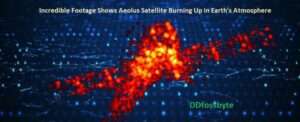In an astonishing display of celestial drama, recent footage has captured the breathtaking descent of a blazing satellite hurtling towards Earth’s atmosphere. This awe-inspiring event has not only intrigued astronomers but also left us in awe of the wonders of space. we delve into the remarkable incident, exploring its significance and the scientific insights it offers.

The European Space Agency (ESA) has released incredible footage of its Aeolus satellite burning up in Earth’s atmosphere. The satellite, which was launched in 2018, was decommissioned in July 2023 and deliberately de-orbited.
The Fiery Plunge
- A Striking Encounter
The event in question occurred when a defunct satellite, no longer under human control, made an uncontrolled reentry into Earth’s atmosphere. As it plummeted through the sky, friction with the atmosphere caused it to heat up, creating a spectacular fireball that could be seen from various vantage points on Earth.
The Science Behind It
- Atmospheric Friction
The satellite’s fiery descent was primarily due to atmospheric friction. As the satellite entered the Earth’s atmosphere at high speed, the air resistance caused it to decelerate rapidly. This deceleration generated an enormous amount of heat, resulting in the fiery trail we witnessed.
- Satellite’s Composition
The composition of the satellite played a crucial role in the intensity of the display. Satellites are often constructed with materials that are designed to withstand the harsh conditions of space. However, when these materials reenter the Earth’s atmosphere, they burn up, creating the mesmerizing spectacle we observed.
A Rare Phenomenon
- Infrequency of Such Events
While satellite reentries are not uncommon, witnessing one from the ground, especially during the day, is a relatively rare occurrence. The timing, location, and visibility of these events depend on several factors, making them a subject of interest for both scientists and space enthusiasts.
Astronomical Implications
- Opportunity for Research
Such events provide astronomers with a unique opportunity to study the dynamics of reentries and the behavior of materials in extreme conditions. Observations and data collected during these events contribute to our understanding of space debris management and reentry predictions.
The Human Element
- Awe and Wonder
The footage of the blazing satellite plummeting to Earth captivated people around the world. It serves as a reminder of the vastness and unpredictability of our universe. Events like these remind us of the importance of space exploration and the need to manage space debris responsibly.

The European Space Agency (ESA) has released photos showing its Aeolus satellite re-entering Earth’s atmosphere in a controlled manner at a speed of 16,700 mph, ultimately burning up over Antarctica. The Aeolus satellite, equipped with powerful laser technology to observe wind patterns globally, was launched in 2018 and played a significant role in improving weather forecasts and climate models during its five-year mission.
Approximately 80% of the satellite burned up during reentry, with 20% surviving. ESA’s assisted reentry approach significantly lowered the risk of surviving fragments landing near inhabited regions and minimized the time the satellite spent uncontrolled in orbit, reducing the risk of collisions with other satellites.
Aeolus’s assisted reentry serves as an example of responsible space operations and efforts to enhance the safety of space missions.

The footage shows the satellite tumbling and glowing as it enters the atmosphere. The heat of the friction causes the satellite to break apart, creating a fiery trail. The satellite eventually burns up completely, without causing any damage to the ground.

The sight of a satellite descending in a blaze of glory is a testament to the wonders of our cosmos. It sparks curiosity, inspires awe, and offers valuable scientific insights. While such events are infrequent, they serve as a compelling reminder of our connection to the universe.
